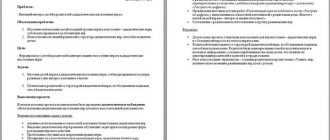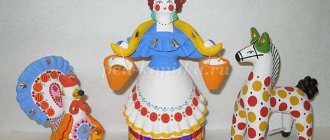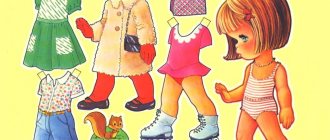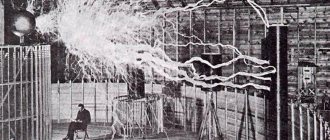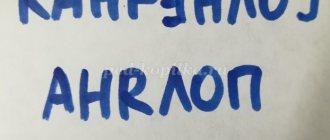Card index of intellectual games
Olesya Vidmanova
Card index of intellectual games
Game "Logic blocks of Dienesh"
Target. To help accelerate the development of the simplest logical structures of thinking and mathematical concepts in preschoolers
Short description:
From a randomly selected figure, try to build as long a chain as possible. Options for building a chain:
so that there are no figures of the same shape (color, size, thickness)
;
so that there are no figures identical in shape and color (in color and size, in size and shape, in thickness)
;
so that there are figures nearby that are the same in size, but different in shape;
so that nearby there are figures of the same color and size, but different shapes (the same size, but different shapes)
.
Game "Math Tablet"
Target. Create conditions for the child’s research activities. Promote psycho-sensorimotor, cognitive (cognitive) development, as well as the development of creative abilities.
Short description:
The game presents diagrams in which children reproduce the drawing using rubber bands and colored figures. The schemes can be supplemented in accordance with the level of development of the child, and you can come up with your own options. The game features diagrams for spatial orientation, counting, geometry, games with numbers, letters, symmetries, road signs, riddles, illustrated poems, fairy tales, and patterns.
Methodical instructions. When working with a group of children, you can conduct visual and auditory dictations on a math tablet.
Game "Geometric Mosaic"
Target. To consolidate knowledge about geometric shapes and primary colors, about the size of objects. Develop visual perception and memory. Promote the development of intellectual abilities .
Short description:
Invite the children to arrange the cut out geometric shapes into groups:
by color (all blue shapes, all green shapes, etc.)
by size (small triangles and large triangles, small squares, large and medium squares, etc.)
by shape (all triangles, all squares, all half circles, etc.)
laying out the same pictures from a set of geometric shapes, first by overlaying them on a card , then next to the picture , and then from memory.
Invite the players to lay out any image from geometric shapes.
"Remember"
Target. Develop visual perception, voluntary attention, memory. Develop visual-figurative thinking
Short description:
There are 12 cards . Tasks for each card to increase complexity . At the first stage, we suggest looking at and remembering what is drawn. card 2 , children determine what has changed compared to the first card . At the next stage, children look at, remember and draw the figures they see, then the numbers, remembering the order in which the numbers are positioned. At the last stage, we invite the child to remember and draw schematic images corresponding to various pictures .
Game "Dangerous Objects"
Target. Develop verbal and logical thinking
Short description:
Having laid out toys and drawings with objects in front of the children, the teacher invites the children to determine which objects are dangerous for play and why, where these objects should be stored. Children tell where dangerous objects should be stored. How to behave if you have such an object in your hands. Is it possible to distract or push a person if he is cutting, sewing, or nailing a nail? What could happen?
Game "Signs"
Target. Teach children to identify the same signs in different objects, develop logical thinking.
Short description:
1-10 people take part in the game. It's better to start with one round card . We invite the child to select 4 suitable cards from 40 cards and attach them so that they logically complement the central card . The number of round task cards should be increased gradually.
Methodical instructions. For a group of children, the game should be competitive - who can complete the task faster.
Game “What is made of what”
Target. To consolidate children's knowledge about various materials and products made from them. Develop logical thinking.
Short description:
1-10 people take part in the game. It's better to start with one round card . We invite the child to select 4 suitable cards from 40 cards and attach them so that they logically complement the central card . The number of round task cards should be increased gradually.
Methodical instructions. For a group of children, the game should be competitive - who can complete the task faster.
Game "First-Grade Quiz"
Target. Help children prepare psychologically for school, teach them to answer questions quickly. Develop speed of thinking.
Short description:
Players take turns, established by agreement or by lot. On his turn, the player rolls the dice and moves the chip to the number of squares drawn. By moving the chip, the player answers the question of a card from a pile of the corresponding color. If the player answered correctly, then the turn passes to the next player. If the player answers incorrectly, the player rolls the die and steps back by the value rolled. After which he immediately answers the question of the color corresponding to the cell. This continues until the player either answers correctly or returns home. The one who comes to school first wins.
Game "Pick up a picture "
Target. Learn to classify objects, name groups of objects with generalizing words, and enrich your vocabulary. Develop attention, memory, thinking
Short description:
A leader is chosen. He shuffles the fields and cards and gives each player one field, and the cards in a separate pile. The presenter takes the top card from the pile and calls it . Using the classification method, players determine whether an item belongs to their card , gives a signal - if the answer is correct, the presenter gives the card . The first one to cover all the areas on his field is declared the winner.
Game "Guess the Animals"
Target. To consolidate knowledge about wild animals, their habitat, and nutrition. Develop logical thinking.
Short description:
A leader is chosen. He shuffles the fields and cards and gives each player one field, and the cards in a separate pile with the text down. The leader takes the top card and reads the text of the riddle on it aloud. If a player who has an image of this animal on the field has guessed the riddle and correctly answered questions about it (where it lives, what it eats, what its character is), then the presenter gives him a card with a riddle . If the player made a mistake, the presenter corrects him, but The card is placed at the bottom of the pile.The first one to cover all the areas on his field is declared the winner.
Game “Where does the bread on the table come from?”
Target. Learn to consistently lay out plot pictures , develop speech, teach to think logically, and develop intellectual abilities .
Short description:
To create a chain, choose one of 3 topics (milk, butter or bread)
First, the adult and the children lay out the chain, and through discussion, choose the correct solution for establishing the sequence of
pictures .
Next, the children independently lay out the chain and compose a story on the topic. Methodical instructions. Try to make any of the chains only in reverse order. Start the story not with the first, but with the last picture of the chain .
Game "Funny Luggage"
Target. Learn to classify objects of one group, select words for a certain sound. Develop mental flexibility.
Short description:
The player with the shortest hair acts first, then his neighbor to the left, then clockwise. Each player has 4 actions:
look at any card ;
put it in place;
without looking, move one card in place of another ;
You can only swap 2 cards .
Actions can be combined in different ways, the main thing is that there are no more than 4 of them. Less is possible.
The one who was able to lay out the last missing card for the train takes this train for himself. The train is a steam locomotive and 4 carriages.
Methodical instructions.
If you just look at the card , it remains face down . If you change cards , you will have to put them face up .
Game "Read the word"
Target. To develop the skills of sound analysis and synthesis , skills of correlating sounds with letters, to promote the formation of smooth, coherent, meaningful reading. Develop attention, memory, logical thinking.
Short description:
At the first stage, the presenter invites the children to highlight the first sounds in the names of objects shown on the card , then pronounce the highlighted sounds, pausing where the window is empty, and name the resulting word. At the second stage, you can ask children to read the word on the game card , find the missing letter and put a chip with this letter on an empty square. At the third stage, ask the children to find the missing letter and mark it with a chip with the desired letter. And at the last stage, at the leader’s signal, the players pick up chips with letters and place them on the empty window. The team that completes the task first reads the words and becomes the winner.
Intellectual game.
Story
Target. Teach children to speak “thin”
voice and low voice. Developing the ability to raise and lower the tone of your voice.
Short description:
The teacher begins to tell the story, accompanying his speech by showing the corresponding figures on the flannelgraph: “Early in the morning, we went out for a walk at the dacha. We hear someone squeaking subtly: “pee-pee”
(pronounces onomatopoeia
in a “thin”
voice).
We look, this chick is sitting on a tree and squeaking; waiting for his mother to bring him a worm. How thinly does the chick squeak? ( “Pi-pi-pi
.”) At this time, the bird flew in, gave the chick a worm and squealed:
“pi-pi-pi” (pronounces onomatopoeia in a lower voice)
.
How did the mother bird squeak? ( "Peep-pee-pee"
.)
The bird flew away and we moved on. We hear someone at the fence shouting subtly: “meow-meow-meow”
(pronounces onomatopoeia
in a “thin”
voice).
And the kitten jumped out onto the path. How did he meow? (Children reproduce the teacher’s example.)
It was he who called the cat mother. She heard it, runs along the path and meows:
"Meow meow meow"
(says
“meow-meow”
in a lower voice).
How did the cat meow? ( "Meow meow meow"
.)
And now, children, I’ll show you who came to visit us.” The teacher takes out the cat, shows how it walks along the table, then sits down. “How does a cat meow?”
Children, lowering their voices, say:
“meow-meow-meow
.
Then the teacher takes out a kitten, a bird, a chick, and the children imitate their voices.
Methodical instructions. Make sure that children do not shout, but speak calmly, raising and lowering their voice within the limits accessible to them.
Game "School of Scouts"
The goal is to be attentive and have good knowledge. The teacher reads the poems, and the participants find errors in them, if any. For the correct answer, the child receives a chip (point)
.
— Having attached fins to their feet, gymnasts swim under the water. (Scuba divers)
.
We play football well, we score goals often. (Not pucks, but balls)
.
The pine tree has shorter needles than the Christmas tree. (Pine needles are longer)
.
From buckwheat Kirill
I cooked semolina porridge.
(Not from buckwheat, but from semolina)
— Blizzards howl like wolves in the winter month of April. (April is not a winter month)
.
For those who are not healthy, we call the doctors
A little net was woven for the fish by a craftsman spider. (Not to fish, but to flies)
.
The theme of the quiz is “Sea Experts”
.
Teams are invited to greet.
Team: We are funny dolphins,
We wish you victories. We will play with you and be smart.
Team II: We are cool octopuses
We also send you our greetings. We know, we know there are no very simple victories.
The game will be judged by a jury.
The rules of the game are as follows. We will ask questions, and you, after consulting with the team, will answer. Whose team answers faster and correctly gets a chip.
Presenter: Dear experts! We received a letter from a fairy-tale character. And from whom exactly, you can guess for yourself by listening to his song. (Turns on music)
.Experts: From Vodyanoy.
Host: That's right, this is a letter from Vodyanoy. He writes that he is completely bored at the bottom of the sea, wants to play with you and has prepared interesting questions . So, let's start the game. Listen to question I.
1. What is the name of the branch of zoology that studies fish?
Answer: Ichthyology.
2. Why do most fish have a streamlined body?
Answer: The streamlined shape allows fish to move easily in the water.
3. Which fish has eyes on one side and a flat body?
Answer: Flounder.
4. In what position does the flounder fish swim faster?
Answer: When the fish turns on its edge.
5. Can fish blink?
Answer: No, she doesn't have eyelids.
6. In which picture was the mistake made and what?
Answer: In the second picture the scales are drawn in the opposite direction. “- 7. Why can’t the scales be positioned like this?
We suggest you conduct an experiment. Pull two cones in the water by a thread - one has scales directed back, and the other - forward. Which lump is easier to pull?
Answer: The one whose scales are spread back. The scales on the body of a fish are located in the same way. They help her glide in the water.
8. How to find out how old a fish is?
Answer: There are rings on the scales. In 1 year, one ring appears. These rings are called annual rings.
9. Remember the name of the largest fish from K.I. Chukovsky’s fairy tale about Barmalei?
Answer: Shark.
Presenter: Shark is the largest fish. This fish reaches a length of 15m. Like a five-story building. It weighs 14 tons, the same weight as 200 men. Sharks are unusually voracious. Living and non-living - everything is eaten by the shark. (Shows the picture “Shark”
).
10. Name the predatory fish?
Game “Where can I see?”
Perfectly develops memory, attention and logic. The whole family can play it. To do this, you need to ask where, for example, you can see a car, scissors, a bicycle, a table, a window or a wheel.
Game "Good and Bad"
An excellent exercise for developing analytical skills “Good and Bad”
. To do this, you need to carefully examine an object, say a pencil, and find out what is good and what is bad about it. For example, you can draw with a pencil, this is good, however, it is fragile and this is bad. In the future, you can complicate the task by analyzing with your child the actions of fairy tale heroes or other people.
Game "It happens or not"
To do this, you need to take a ball and, throwing it, come up with different situations. For example: “The water is burning”
,
“A fish walks on the lawn in boots
,” and the child must answer whether this happens or not.
Graphic tasks are also less useful for the development of children 4-5 years old. For example, the game “Connect the dots”
will help the child master the sequence of actions and promotes the development of motor skills.
The task for the child is to connect all the dots with lines and get a picture or figure .
Game "Labyrinth"
Trains attention and logic. The task is to help, for example, a bunny find its way to a hole. To do this, you need to draw a line through tricky “tunnels”
labyrinth
“Complete the object”
It will teach the child analysis, the ability to isolate component parts from a whole. Various puzzles and sets for creating a sequential picture or plot also develop logic well.
Speech games that develop thinking include riddles. In this case, the child is given information that is well known to him, on the basis of which he must draw a logical conclusion.
Game “Edible-Inedible”
Perfect for travel or walking. The adult names the item or object, and the baby must answer whether it is edible or not.
Game "Say the Word"
It is designed for the ability to select associations for familiar words and look for relationships between them. For example: squirrel-nut. It’s worth clarifying here that the squirrel loves to eat nuts. Then, according to the analogy, the child must add a word, for example, to the word "dog"
.
Here it would be appropriate to choose the word “bone”
and explain that dogs love to chew bones.
